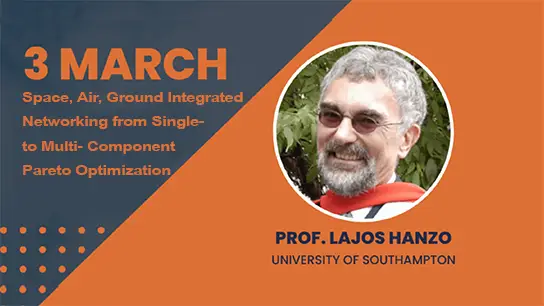-
Members: FreeVTS
IEEE Members: $11.00
Non-members: $15.00Length: 33:39
01 Sep 2022
The next 6G cellular networks will be a rendezvous between localization, sensing, and communication. Indeed, through their design, new applications, such as cross/augmented reality, radio holography, and autonomous vehicle navigation, will be enabled at an unprecedented accuracy and reliability. . In addition, localization and sensing will coexist with communication in the same radio spectrum by sharing the same hardware. Hence, their codesign will be another aspect to be investigated, as well as the capability to minimize overhead, power consumption, and re-deployment cost, i.e., in comparison with ad-hoc conventional localization and sensing approaches.
Towards this vision, reconfigurable intelligent surfaces (RISs) have already been identified as a potential technology thanks to the possibility to shape the electromagnetic environment intelligently, enhancing ambient awareness. For example, the high mobility of users (e.g., drones and vehicles) might be assisted by RIS for easing the handover failures or supporting autonomous navigation and localization-based applications. Nevertheless, RISs are expected to be beneficial not only in terms of achievable spatial accuracy or system scalability but also continuity, e.g., for overcoming most pathological non-line-of-sight conditions. They shall indeed enable a timely/localized adaptation to various location-based application requirements and on-demand service provision in complex multi-user multi-operator contexts, e.g., in terms of both localization and sensing accuracy and/or addressed/preferred spatial dimensions.
Besides RIS, unmanned aerial vehicles (UAVs) and adopting higher frequency bands (e.g., millimeter-waves and TeraHertz) are expected to be key enablers for joint localization, sensing, and communications in 6G networks. All these capabilities raise open research questions related to, e.g., multi-objective multi-constraint optimization, localization-oriented RIS and UAV control, and suitable estimation algorithms at both single-link and multi-link levels
The goal of this workshop was to bring together researchers and experts from academia and industry, and to discuss and promote the research and development needed to overcome the major challenges on the related topics.
Towards this vision, reconfigurable intelligent surfaces (RISs) have already been identified as a potential technology thanks to the possibility to shape the electromagnetic environment intelligently, enhancing ambient awareness. For example, the high mobility of users (e.g., drones and vehicles) might be assisted by RIS for easing the handover failures or supporting autonomous navigation and localization-based applications. Nevertheless, RISs are expected to be beneficial not only in terms of achievable spatial accuracy or system scalability but also continuity, e.g., for overcoming most pathological non-line-of-sight conditions. They shall indeed enable a timely/localized adaptation to various location-based application requirements and on-demand service provision in complex multi-user multi-operator contexts, e.g., in terms of both localization and sensing accuracy and/or addressed/preferred spatial dimensions.
Besides RIS, unmanned aerial vehicles (UAVs) and adopting higher frequency bands (e.g., millimeter-waves and TeraHertz) are expected to be key enablers for joint localization, sensing, and communications in 6G networks. All these capabilities raise open research questions related to, e.g., multi-objective multi-constraint optimization, localization-oriented RIS and UAV control, and suitable estimation algorithms at both single-link and multi-link levels
The goal of this workshop was to bring together researchers and experts from academia and industry, and to discuss and promote the research and development needed to overcome the major challenges on the related topics.


